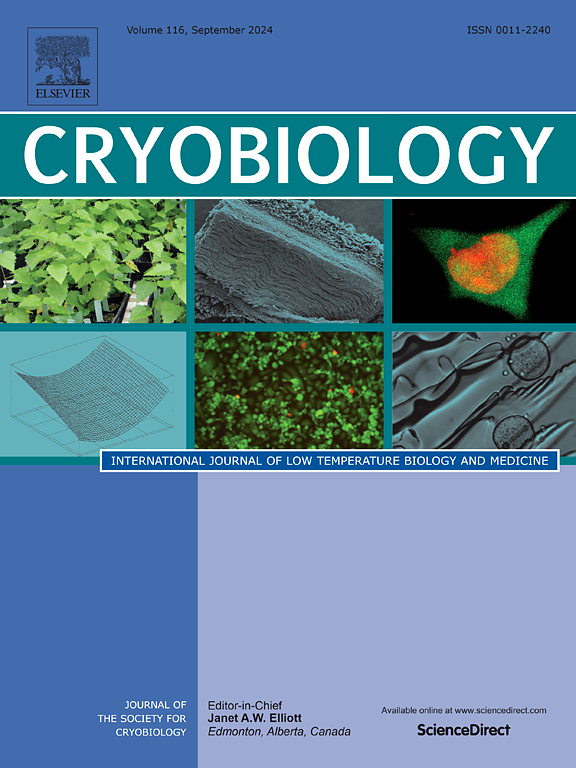蛋白质羰基化揭示了水牛精子低温损伤的分子基础
IF 2.3
3区 生物学
Q2 BIOLOGY
引用次数: 0
摘要
在低温保存过程中,精子生物分子发生氧化损伤,最终影响其受精能力。简单的蛋白质组分析可能不能准确反映受影响的细胞功能,因为大多数羰基化蛋白质失去了它们的功能。羰基化蛋白是氧化应激的良好标志。以水牛精子为研究对象,采用生物素酰肼亲和层析法和单体亲和琼脂糖基质对新鲜延长精子(FESCL)和冻融精子(FTSCL)中的羰基化蛋白进行富集,并进行质谱分析。使用Proteome Discoverer (v2.2)分析数据,使用SEQUEST进行翻译后修饰分析,使用FunRich工具(v3.0)预测受影响的功能活性。精子蛋白质谱分析鉴定出415个羰基化蛋白,其中FESCL为151个,FTSCL为405个。仅在FTSCL中发现的12种高度丰富的羰基化蛋白可能是低温损伤的主要贡献者。低温保存诱导选择性精子蛋白的羰基化。共有98个多肽被精确地注释为具有氧化修饰。与FESCL相比,FTSCL中各种细胞成分、途径和过程中的更多蛋白质被羰基化。研究结果表明,羰基化蛋白通过影响能量代谢、自由基清除、细胞骨架、质膜、获能、透明带结合和精子-卵母细胞相互作用等途径对精子进行分子损伤,并与精子的功能参数密切相关。这些发现有力地证明了蛋白质羰基化是低温损伤的主要因素和分子基础之一,损害了FTSCL的功能。随着冷冻保存成为一种不可避免的工具,该研究变得更加相关,并且该实验设计将提供具有良好分子图谱的高质量冷冻解冻精子。本文章由计算机程序翻译,如有差异,请以英文原文为准。
Protein carbonylation reveals the molecular basis of cryoinjury in buffalo spermatozoa
During cryopreservation, oxidative damage to sperm biomolecules occurs, ultimately compromising its fertilizing ability. Simple proteome analysis may not accurately reflect the cellular functions that are affected, as most carbonylated proteins lose their functions. The carbonylated proteins act as a good marker of oxidative stress. Choosing buffalo spermatozoa as a model, carbonylated proteins from fresh-extended (FESCL) and frozen-thawed (FTSCL) spermatozoa were enriched by affinity chromatography using biotin hydrazide and a monomeric avidin agarose matrix followed by mass spectrometry. Data were analyzed with Proteome Discoverer (v2.2), post-translational modification analysis was performed using SEQUEST, and affected functional activities were predicted using the FunRich tool (v3.0). The mass spectrometric analysis of sperm proteins led to the identification of 415 carbonylated proteins, 151 in FESCL and 405 in FTSCL. Twelve highly abundant carbonylated proteins identified only in FTSCL can be the major contributors to the cryoinjury. The cryopreservation induces the carbonylation of selective sperm proteins. A total of 98 peptides have been precisely annotated that have oxidative modifications. In comparison to FESCL, more proteins in various cellular components, pathways, and processes in FTSCL were carbonylated. The findings indicate the molecular injury to spermatozoa through carbonylated proteins affecting energy metabolism, free-radical scavenging, cytoskeleton, plasma membrane, capacitation, zona-pellucida binding, and sperm-oocyte interaction and are well correlated with the functional parameters of the spermatozoa. The findings provide strong evidence that protein carbonylation is one of the major factors and molecular basis of cryodamage, which compromises the functions of FTSCL. With cryopreservation becoming an inevitable tool, the study becomes more relevant, and this experimental design would give better-quality frozen-thawed spermatozoa with good molecular profiles.
求助全文
通过发布文献求助,成功后即可免费获取论文全文。
去求助
来源期刊

Cryobiology
生物-生理学
CiteScore
5.40
自引率
7.40%
发文量
71
审稿时长
56 days
期刊介绍:
Cryobiology: International Journal of Low Temperature Biology and Medicine publishes research articles on all aspects of low temperature biology and medicine.
Research Areas include:
• Cryoprotective additives and their pharmacological actions
• Cryosurgery
• Freeze-drying
• Freezing
• Frost hardiness in plants
• Hibernation
• Hypothermia
• Medical applications of reduced temperature
• Perfusion of organs
• All pertinent methodologies
Cryobiology is the official journal of the Society for Cryobiology.
 求助内容:
求助内容: 应助结果提醒方式:
应助结果提醒方式:


